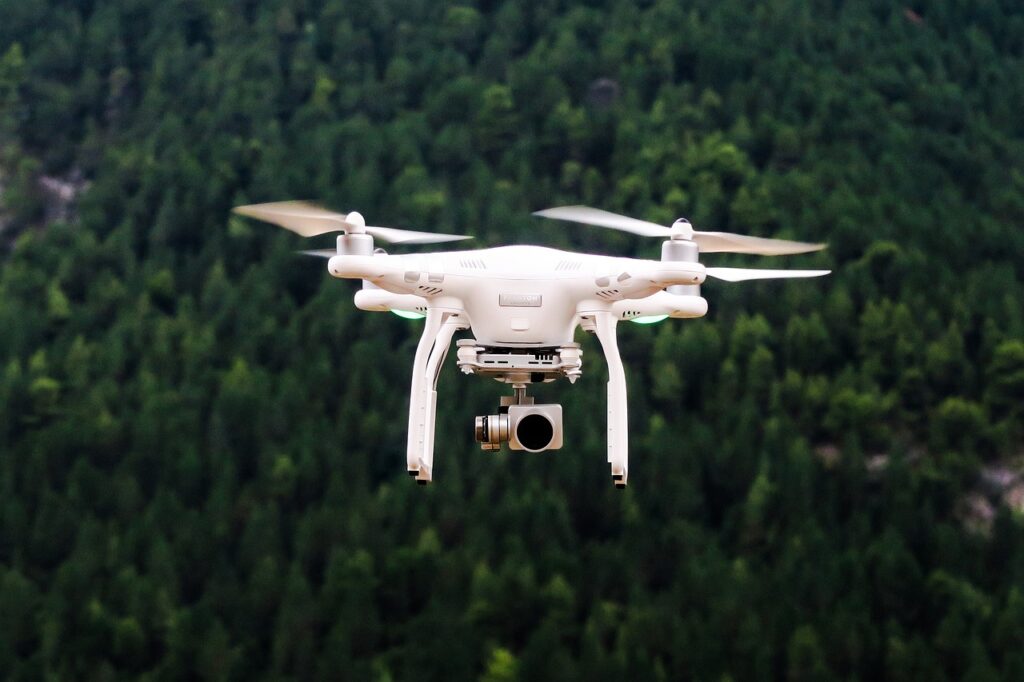A brief introduction to drones
Since the invention of the first camera, taking photos and shooting videos has always been a hobby that has fascinated many people. Today, these topics continue to attract a lot of interest, but modern technology offers a much wider range of possibilities. This includes the option of taking photos and videos from a bird’s eye view. The best way to take such shots is with a drone. However, it is no longer just fans of photography and videography who enjoy this hobby. The drone itself, as well as its technical equipment, appeals to many, so the community of users has grown significantly in recent years.
Below, you will find everything you need to know about drones, giving you a better idea of the products available on the market and helping you find the right model for you. We will also explain what you need to bear in mind when using a drone to ensure that everything is legally above board.
Possible uses for drones
Most models on the market have the ability to take photos and record videos. However, they are also interesting for you if you are interested in drone flying. Depending on their technical equipment, they now have high-quality HD cameras that not only offer high resolution but also other features to make the videos appear as high-quality as possible.
Unfortunately, there are certain legal requirements associated with the use of this wonderful gadget. The so-called drone law broadly covers the following guidelines:
- They must be registered if they exceed a weight of 250 grams and are capable of recording images and sound.
- Anyone who wants to operate a drone is required to take out liability insurance.
- In some areas, as well as for the use of certain features of the drone, official permits are required.
- They may not exceed a flying height of 120 metres. Designated model airfields must be used for higher flying heights.
- Operation within residential properties and nature reserves is prohibited without permission.
- At night, they must always be equipped with a flashing light.
In addition, further guidelines are set out in the Drone Act. These include, for example, maintaining a safe distance and a labelling requirement. Many of the regulations mentioned here are intended to protect the privacy and safety of the population.
You should also obtain a drone licence, which is required for drones above a certain size in order to obtain permission to operate such an aircraft. You can obtain a licence from the age of 16.
However, there is one exception to the rule: drones that comply with EU toy directives are exempt from the above regulations.
We generally recommend that you familiarise yourself thoroughly with the legal requirements and regulations before purchasing a drone so that you are well prepared.
Target group for drones
Drones appeal to many different groups of people. These include not only private individuals of both sexes and all ages, but also professional drone pilots who use the videos and photos for work.
What makes a high-quality drone?
The quality of a drone is determined not only by its workmanship, but also by the materials used in its production. Although most drones are made of plastic, this plastic should have a certain degree of strength and stability. The option to purchase spare parts is desirable, but not available for most smaller models. However, some manufacturers include one or two spare parts in the scope of delivery.
As there are certain requirements for operating drones in the UK, it is advisable to check for the CE mark and whether or not the drone complies with the EU Toy Safety Directive.
Buying advice – what should you look out for when buying?
When looking for the right supplier, it is important to pay particular attention to their transparency. Does the website provide a way to contact the supplier and an imprint? If so, you have taken the first step in the right direction. You should also check how much information they provide about the drones on offer. Does this give you a clear picture of the drones, or do you still have questions? Reputable suppliers also provide detailed information about the technical characteristics of the drones. Depending on whether you have flown a drone before or not, you should pay attention to the controls. These should be as intuitive as possible so that you have no difficulty getting started.
Drone reviews from the internet
Many drones available online have good technical features and are compact enough to comply with the EU Toy Safety Directive. As a result, they are popular with many users and are often purchased as gifts for the younger generation. In addition to beginners, advanced users can also benefit from the capabilities of the drones on offer and enjoy using them.
Drone FAQ
Let’s now take a look at some frequently asked questions about drones. The aim is to give you an even better insight and perhaps provide you with answers to questions that have not already been answered in the article.
Q: How can the videos be processed later?
A: In most cases, you use the drone’s camera to record videos or take photos, which are then immediately transferred to the connected smartphone. However, there are also models that allow the use of an SD card. You can find detailed information about this from the manufacturer.
Q: Can I view the videos directly on my smartphone?
A: That depends mainly on the camera’s functions. Many transfer the videos directly to the screen of the smartphone, which you also use to control the drone.
Drones – Technical facts
When it comes to technical facts, you should pay particular attention to the following:
- Information on the quality of video and photo recordings (preferably HD or 4K resolution)
- Presence of sensors to prevent accidents during flight
- Operation via a separate controller or app control only
- Compatibility with different operating systems
- Information on battery life and charging time
- Availability of different flight modes, such as auto-pilot or auto-landing, etc.
Drones: advantages and disadvantages
Every gadget has its own advantages and disadvantages, which we would like to summarise briefly for you here:
Advantages
- Most models are easy to control.
- Appeals to a very wide target group.
- High-quality videos and photos are possible.
- HD or even 4K resolution for the camera.
- Many models comply with the EU Toy Safety Directive despite their high quality.
Disadvantages
- Some manufacturers are sparse with information about technical specifications.


